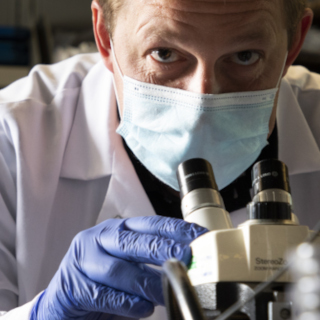Rodent Genotyping and Identification
Last Review Date: August 24, 2020
I. Purpose and Scope
The purpose of this Standard Operating Procedure (SOP) is to provide guidelines to researchers regarding acceptable methods for identifying individual animals (e.g., ear punching) or collecting tissue for the purpose of rodent genotyping.
II. Policy
It is LAR policy to meet or exceed all federal, state, and local regulations and guidelines and to comply with all institutional policies and procedures as they apply to the use of animals in research. Personnel must attend any applicable training in animal care and use, occupational health and safety, equipment operation, and SOPs prior to performing activities outlined in this SOP or work under the direct supervision of trained personnel.
III. Procedures
The Institutional Animal Care and Use Committee (IACUC) must approve all invasive methods for rodent identification or tissue collection prior to performing procedures on animals.
A. Ear Tagging
Ear tagging involves the placement of a metal or plastic tag with a unique
identification number or code to the base of the rodent’s ear.
1. Animals must be 14 days or older.
2. Ear tags should be sterile or disinfected prior to placement.
3. The ear should be disinfected prior to placement with chlorhexidine or 70% alcohol.
4. Ear tags should be placed in the lower outer third of the ear to facilitate normal ear
positioning and to avoid areas with the highest concentration of capillaries.
5. Ear tags must be placed such that they do not cause a bend in the pinna, interfere
with the animal’s mobility, or be placed in such a manner that they can catch on
any part of the caging.
B. Ear Punching and Notching
This Identification method involves punching a hole or making a notch in the ear
pinna. Commercial ear punches are available and inexpensive. Ear notch or punch
tissue remnants can usually provide enough tissue for genotyping.
1. Ear notching or punching may not be performed on animals ≤ 14 days.
2. Ear punching or notching does not require the use of anesthetics or analgesics,
however, for identification purposes the animal must be appropriately restrained to
ensure proper technique.
3. The ear punch device must be disinfected between animals (these devices can be
autoclaved).
C. Tail Clipping
This tissue collection method involves amputating a very small segment of the distal
tail. At < 21 days of age, the degree of ossification of the coccygeal vertebrate in the
distal 5 mm is much less than that at 1 cm. After 21 days of age, the degree of
ossification is similar along the entire length of the tail. The perception of pain is
assumed to be more likely in bony vs. cartilaginous tissue. Tail clipping on mice or rats ≤
21 days of age does not require anesthesia.
1. Animals must be appropriately restrained during the procedure to minimize
trauma
2. Sterile sharp scissors (must be disinfected between uses) or a sterile blade per
animal can be used for the procedure.
3. Only the distal 5 mm of the tail should be amputated.
4. Hemostasis can be achieved by using a silver nitrate stick, Quick Stop powder, or
by applying a gauze sponge over the site with gentle pressure until bleeding stops.
5. Animals > 21 days of age or animals requiring a second tail sample must be
appropriately anesthetized using ketamine/xylazine, isoflurane, or a local
anesthetic .
6. Animals > 35 days of age that require tail clipping must be anesthetized
(ketamine/xylazine, isoflurane, or local anesthetic) and administered a systemic
analgesic given at least once following the procedure.
7. If multiple tail clippings are required a maximum of 1 cm total tail length may be
amputated.
D. Toe Clipping
Toe clipping, as a method of identification of small rodents, should be used only when
no other individual identification method is feasible and should be performed only on
altricial neonates and when combined with genotyping. The specific method(s) must
be described in the Animal Use Protocol (AUP) and appropriate scientific justification
provided. Under all circumstances, aseptic technique must be followed.
This method involves removal of the distal phalangeal bone of one or more limbs. Toe
clipping has the potential to induce pain and distress, and alter the animal’s gait and
ability to feed.
1. Only one toe per foot may be amputated.
2. Sterile sharp scissors can be used for this procedure and must be disinfected
between uses.
3. Hemostasis can be achieved using a silver nitrate stick, Quick Stop powder, or by
placing a gauze sponge over the amputation site and applying gentle pressure
until bleeding has stopped.
4. Toe clipping may only be performed in mice ≤ 12 days and rats ≤ 7 days.
E. Other Methods of Identification
1. Micro Chipping: A small microchip transponder is injected subcutaneously
between the scapulae of the rodent.
a. The micro chip is detected by use of an electronic reader.
2. Micro-tattooing: A permanent mark using a needle and ink which is applied to the
tail, toes, or foot pads.
a. The tattoo equipment must be disinfected between animals.
3. Non-toxic markers: Sharpies can be used to mark the tail or fur of rodents; however,
the marks must be reapplied every 24 hours (or as needed) to ensure the mark
remains visible.
4. Animal Marker™ is another product available which can be used on rodent fur.
a. The Animal Marker™ can remain visible for 6 -12 weeks.
IV. References
1. Guide for the Care and Use of Laboratory Animals, 8thEdition pg. 75.
2. Hankenson FC Laire, Garzel LM, Fischer DD, Nolan B, and Hankenson KD.
Evaluation of tail biopsy collection in laboratory mice (Mus musculus): Vertebral
ossification, DNA quantity, and acute behavioral responses. J Am Assoc Lab Anim
Sci 47:10-18, 2008.
3. Vachon P. Anatomical and histological observations of fore- and hind limb toes in
adult mice after amputations performed at the age of two weeks. Can J Vet
Res 1998;62:311–13.
